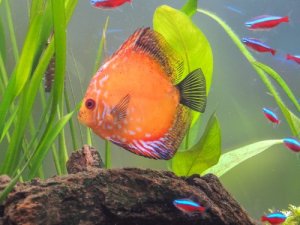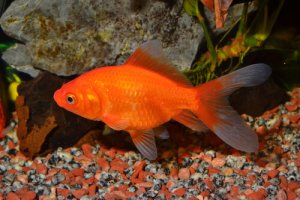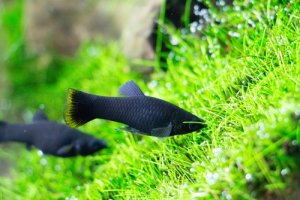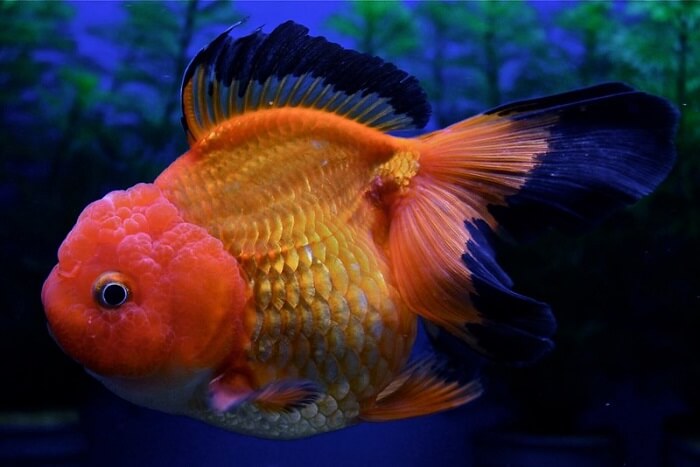
Breed Overview
| Origin | China |
| Lifespan | 10-15 yrs |
| Size | Adults can grow up to 5-8 inches/13-20 cm in total |
| Colour | Red, orange, blue, yellow, white, and bi-colored |
| Food | Omnivorous |
| Tank Size | 30 gallons/114 liters + 10 gallons/38 liters per additional fish |
| Temperament | Curious and gentle |
| Water Type | Freshwater |
| Water Temperature | 58 – 73 F/15-23 C |
| Water pH | 7-8 |
Species Summary
You may have asked yourself ‘What is lionhead goldfish’ after hearing about this kind of fancy goldfish online or otherwise. It is true that the lionhead isn’t as common as some other goldfish types in the average pet store. Therefore you may wonder how they differ.
The easy answer is the lionhead goldfish is a fancy goldfish with a raspberry-shaped growth, or ‘wen’ on the top of its head, and an egg-shaped body. These two traits mean it is more sensitive than some other goldfish and is thus not for beginners. To go further, the lionhead goldfish originated in china, where the very first fancy goldfish with similarly shaped bodies were also developed.
It is not known when the first goldfish with the wen, or growth on the head, appeared, but we do know that the lionhead eventually found its way to Japan, where it was then taken to America and popularised worldwide.
You may also have heard of the ranchu goldfish, which is a descendant of the lionhead but is not the same fish. Likewise, the lionchu is a cross between ranchu and lionhead goldfish. Read on to find out more about the mysterious lionhead.
Buying A Lionhead Goldfish
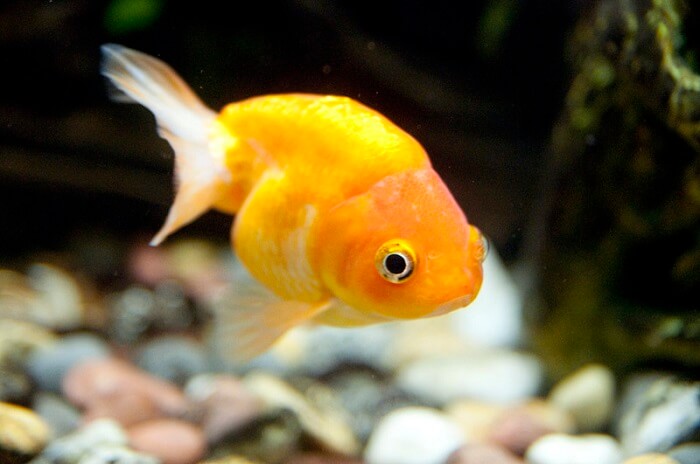
When purchasing and taking home your lionhead the first thing to note is that these fish have special requirements. Therefore, it’s best to have your tank completely set up and to acclimatize them to the water instead of immediately releasing them straight into the tank.
When choosing a fish opt for one with a longer body as there is therefore less pressure on their swim bladder and they won’t be as prone to swim bladder disease. This swim bladder is a really important organ that actually helps your fish stay afloat in the water.
When acclimatizing your fish, float the bag that you took it home in the tank while keeping the top of the bag open. This means the temperature inside and outside the bag will eventually become the same and the fish will be able to happily swim out without too mucus hock to its system.
What Colors Do Lionhead Goldfish Come In?
Lionhead goldfish can come in a variety of colors from red, to white, calico, black blue, and silver. Some of these don’t necessarily describe what the fish looks like, for example, blue tends to look more like a dusky grey. Alternatively, you can get a variant called a red cap – white with a red wen.
Lionhead Goldfish Tank Setup
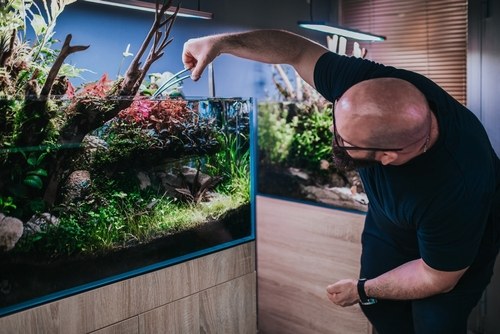
Water parameters
| Ideal Size | Minimum 30 gallons/114 liters + extra 10 gallons/38 liters per fish |
| Suitable Substrates | Sand or gravel |
| Filtration Systems | Minimum flow rate 4x tank volume |
| Ammonia and Nitrites | Zero |
| pH Level | 7-8 |
| Temperature | 58-74 F/15-23 C |
| Lighting | LED bulb |
| Tank Maintenance | Change water once a week and clean the filter every three months by washing in dirty tank water. |
Tankmates And Environment
Your lionhead will benefit best from other goldfish with similar body shapes and head growths such as the ranchu goldfish or oranda. A tank with these three kinds of species can do well, but remember that sometimes simple is better and the lionhead enjoys tankmates of its own kind.
They are placid, easygoing fish, and are rarely aggressive, so including smaller fish such as rosy barbs is also not a problem. They won’t try to attack these but will instead just keep themselves to themselves. There are many species that can make ideal tankmates.
One thing to note is that your fish won’t do well with sharp objects. This is because they can damage their delicate bodies and the hooded growth on their head. Likewise, because of their poor swimming ability, they need room to maneuver. It’s best that even though they enjoy some hiding spots in between plants, they have enough space to swim freely so don’t add anything too narrow where they can get trapped.
Plants For A Lionhead Goldfish Tank
Lionhead goldfish can be prone to digging up plants, but plants really do help keep the water clear and clean for these sensitive fish. Plus, a well-planted aquarium looks great and can keep your fish happier by offering them places to hide and feel safe.
The best plants are those that you can actually let root in a soil substrate. As a result, your fish can’t eat them in the same way that they will voraciously devour floating plants such as duckweed or amazon pennywort. These plants include anubias, java fern, java moss, and cabomba, all of which can either be planted or attached to a rock.
Feeding Your Lionhead Goldfish
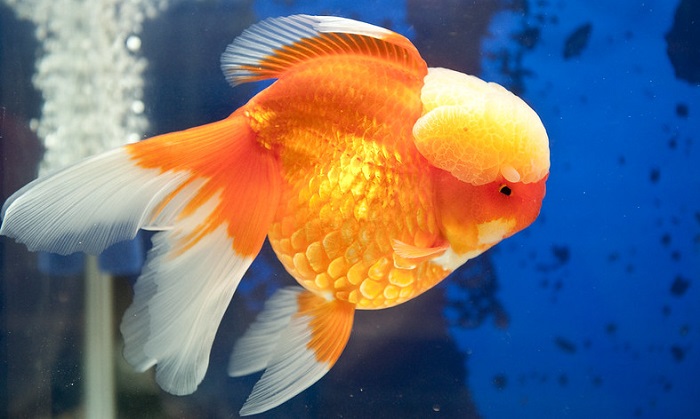
With such attractive and unusual-looking fish, you may wonder what other things can keep them happy and healthy. The lionhead, like all goldfish, benefits from a varied diet. This means that in addition to a good quality sinking pellet food which should form the base of your fish’s diet, the lionhead also enjoys vegetable matter and protein. Sinking pellets prevent your fish gulping down air from the surface.
Protein is can increase the vibrancy of your fish, but feed it in moderation because it also encourages the growth of the wen which can obstruct the eyes of your fish or even the gills. Feed protein in moderation, approximately two to three times a week. It helps to stick to frozen protein too, as it’s easier for your fish to catch.
However, as well as protein, spirulina algae can actually enhance your lionhead’s color, adding to their already majestic appearance. It also promotes general growth and maintains your fish’s health. Some commercial fish foods actually already include spirulina, so check on the back of the packet.
Behavior And Temperament Of Lionhead Goldfish
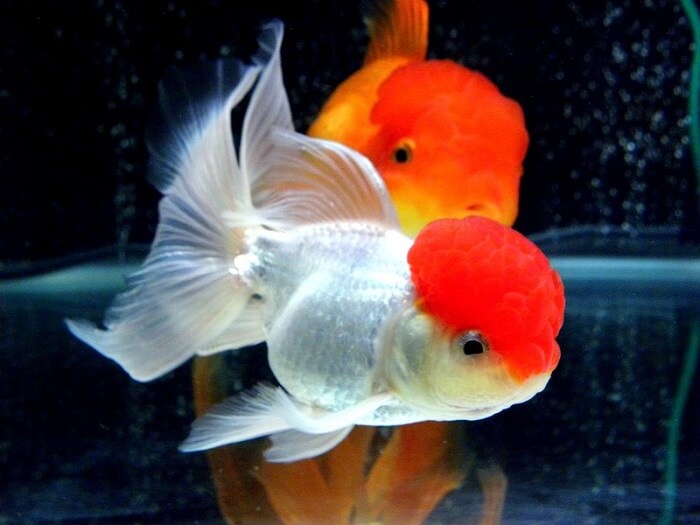
These are generally peaceful fish and they don’t tolerate stress well. This is one reason why they prefer to share a tank with other peaceful fish.
However, that doesn’t mean they don’t enjoy exploring their environment. It’s cruel to keep any fish in a bare tank and a lionhead goldfish is no exception. You will notice these quirky and eye-catching fish swimming through every part of their tank from foraging on the substrate and amongst the roots of plants to swimming with each other and interacting.
Occasionally they need to take a break, which can mean floating near the top of the tank or sitting near the bottom. In the latter case, this can sometimes just mean your goldfish is asleep! However, unusual lethargy or change in their usual inquisitive behavior indicates that they may be sick.
Pests And Diseases Of Lionhead Goldfish
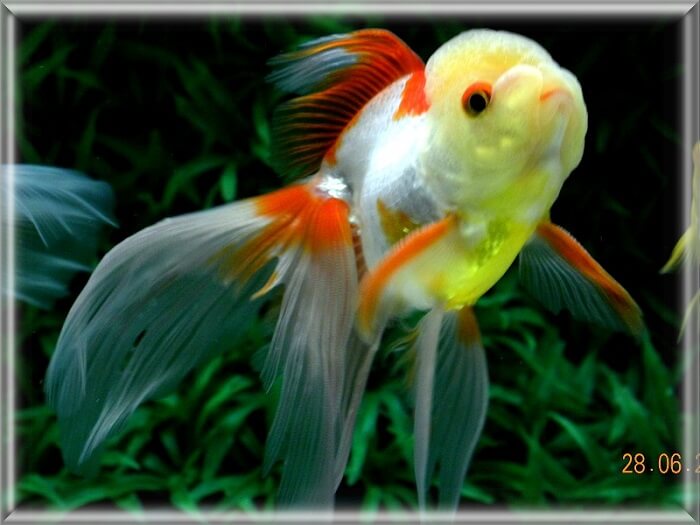
1. Dropsy
Dropsy is a disease that affects the kidneys and thus your fish’s water retention. In fancy goldfish, it may not be immediately apparent due to their egg-shaped body. However, you can notice it if your fish rolls from side to side in the water, or its scales are sticking out, giving it a shape like a pinecone. Dropsy can be serious and hard to cure, so it’s best to prevent it in the first place by maintaining clean water conditions.
2. Bacterial Infections
These can take a number of forms but one of the biggest to look out for in lionhead goldfish is an infection of the wen. This can happen if your fish injures it on something, or if your fish gets food stuck between the folds of the wen. If this is the case, you’ll have to see a specialist aquatic vet, as this is such a sensitive area of the fish.
3. Ich/White Spot Disease
Ich or white spot disease is pretty easy to identify as true to its name, it causes the appearance of lots of white spots all over your fish’s body. It is caused by a protozoan parasite.
It can be treated with over-the-counter medications but always remove the fish to a new aquarium first and change the water in the old one. It’s also best to test for ammonia and nitrates too as dirty water increases your fish’s susceptibility to parasites.
4. Black Spot Disease
Black spot is rarer than white spot disease but still possible and causes lots of small black spots to form on your fish. This can be one reason why your goldfish is turning black. It is caused by a parasitic fluke that lives part of its lifecycle in fish and part in snails. To clear it up, give your goldfish a saltwater bath in a separate tank to prevent the parasite from continuing its lifecycle.
5. Hole-In-head Disease
Hole-in-head disease is a serious parasitic infection that can look shocking due to the way that small circular holes appear in your fish’s head. Though it can more commonly affect oscar fish and other cichlids, as well as discus fish, it’s important to know about it to distinguish it from normal variations in your fish’s wen.
Hole-in-head is caused by a parasite called hexamita. To treat it you need medication to kill the parasite, as well as cleaning the water and potentially transferring your fish to a new tank, plus dietary supplements to help your fish heal.
6. Swim Bladder Disease
Swim bladder disease is caused by either a parasitic or bacterial infection which means your fish can no longer use its swim bladder to stay afloat. You may see your fish struggling to maintain position in the water, and ultimately this is a sign that the water is dirty.
Remove your fish to another tank and this can be treated with an over-the-counter medication, although it’s best to see a specialist aquatic vet if you are unsure of the cause of the infection.
7. Wen Overgrowth
Lastly, wen overgrowth is not a disease but simply the instance when the fish’s wen grows to cover its eyes or gills so it cannot see or breathe. It’s very important therefore to do something about it quickly, but this normally involves clipping the wen which many first-time owners are unable to do at home. Therefore, with this one it’s also best to get specialist advice.
Breeding Your Lionhead
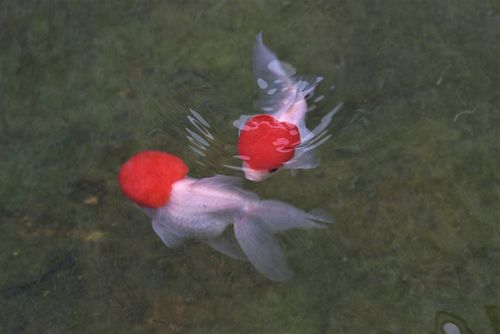
Breeding a lionhead goldfish should only be done if you’ve got a good amount of experience breeding other, less sensitive fancy goldfish such as the fantail. Therefore, this breakdown assumed you’re already familiar with the specifics of how goldfish mate.
- Breeding The Lionhead Naturally
To breed your fish naturally, you’ll have to set up a separate tank and provide a breeding mo or spawning mat as goldfish spray over a thousand eggs at any one time and these need something to stick to.
When your fish are ready to breed you will see that the female has a slightly rounded abdomen where she is carrying the eggs, and the male has white tubercles on his gills. You will also need to lower to water temperature to 54 F/12 C or so before raising it again to between 60-74 F/15-23 C to instigate spawning, as this mimics the natural water temperature increase in spring when the wild ancestors of these carp would have bred.
Now comes one of the most spectacular parts of the process! You will see your fish begin to chase each other around the tank, with the male pursuing the female, until she drops the eggs. After this, the male will fertilize them.
- Breeding By Hand
If you can’t induce your female to drop her eggs, or the male isn’t chasing the female but she is still carrying eggs, you can actually massage your fish’s abdomen to encourage her to release them. This isn’t suggested for first-time fish breeders because of the risk of hurting your lionhead in the process.
It’s best for experienced aquarists. However, if you have bred goldfish before and can tell the female is ready, this is an option for the lionhead just like with any other hardier goldfish – just make sure you’re careful of their wen!
- Breeding Healthy Lionhead Goldfish
Sometimes, these fish can suffer due to their egg-shaped body and the pressure this puts on their swim bladder or digestive system.
After breeding you may, unfortunately, have to cull some of your fish, otherwise, the number is simply unsustainable. In this case, it’s best to choose fish to cull that are on the shorter side in terms of body shape – these are less likely to survive and thrive to adulthood due to how it affects their internal organs.
Final Thoughts
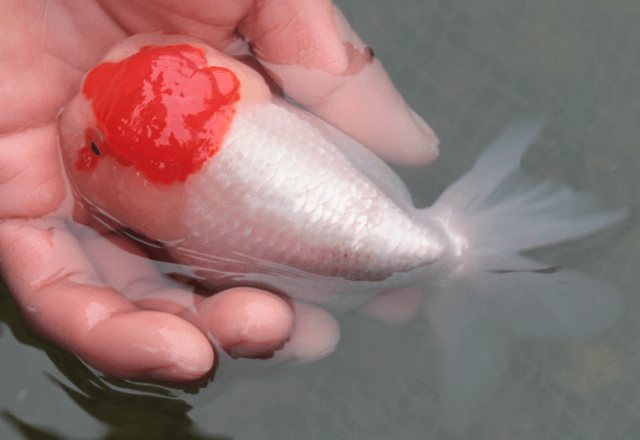
The lionhead is an impressive, majestic variety of goldfish that is a delight to watch slowly drift past you in a tank. However, although these fish look amazing they are also a big responsibility and any hobbyist will need to take special care of them. Nevertheless, with their charm and peaceful behavior, they will reward you for looking after them with a tank that is a delight to watch in every way.


